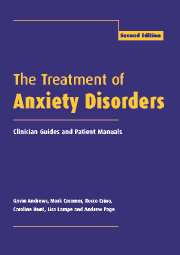Book contents
- Frontmatter
- Contents
- List of authors
- Preface to the second edition
- Abbreviations
- 1 Read me
- 2 General issues in anxiety disorders
- 3 General issues in treatment: Clinician Guide
- 4 Panic disorder and agoraphobia: Syndrome
- 5 Panic disorder and agoraphobia: Treatment
- 6 Panic disorder and agoraphobia: Clinician Guide
- 7 Panic disorder and agoraphobia: Patient Treatment Manual
- 8 Social phobia: Syndrome
- 9 Social phobia: Treatment
- 10 Social phobia: Clinician Guide
- 11 Social phobia: Patient Treatment Manual
- 12 Specific phobias: Syndrome
- 13 Specific phobias: Treatment
- 14 Specific phobias: Clinician Guide
- 15 Specific phobias: Patient Treatment Manual
- 16 Obsessive-compulsive disorder: Syndrome
- 17 Obsessive-compulsive disorder: Treatment
- 18 Obsessive-compulsive disorder: Clinician Guide
- 19 Obsessive-compulsive disorder: Patient Treatment Manual
- 20 Generalized anxiety disorder: Syndrome
- 21 Generalized anxiety disorder: Treatment
- 22 Generalized anxiety disorder: Clinician Guide
- 23 Generalized anxiety disorder: Patient Treatment Manual
- 24 Posttraumatic stress disorder: Syndrome
- 25 Posttraumatic stress disorder: Treatment
- 26 Posttraumatic stress disorder: Clinician Guide
- 27 Posttraumatic stress disorder: Patient Treatment Manual
- 28 Conclusions
- References
- Index
14 - Specific phobias: Clinician Guide
Published online by Cambridge University Press: 05 August 2016
- Frontmatter
- Contents
- List of authors
- Preface to the second edition
- Abbreviations
- 1 Read me
- 2 General issues in anxiety disorders
- 3 General issues in treatment: Clinician Guide
- 4 Panic disorder and agoraphobia: Syndrome
- 5 Panic disorder and agoraphobia: Treatment
- 6 Panic disorder and agoraphobia: Clinician Guide
- 7 Panic disorder and agoraphobia: Patient Treatment Manual
- 8 Social phobia: Syndrome
- 9 Social phobia: Treatment
- 10 Social phobia: Clinician Guide
- 11 Social phobia: Patient Treatment Manual
- 12 Specific phobias: Syndrome
- 13 Specific phobias: Treatment
- 14 Specific phobias: Clinician Guide
- 15 Specific phobias: Patient Treatment Manual
- 16 Obsessive-compulsive disorder: Syndrome
- 17 Obsessive-compulsive disorder: Treatment
- 18 Obsessive-compulsive disorder: Clinician Guide
- 19 Obsessive-compulsive disorder: Patient Treatment Manual
- 20 Generalized anxiety disorder: Syndrome
- 21 Generalized anxiety disorder: Treatment
- 22 Generalized anxiety disorder: Clinician Guide
- 23 Generalized anxiety disorder: Patient Treatment Manual
- 24 Posttraumatic stress disorder: Syndrome
- 25 Posttraumatic stress disorder: Treatment
- 26 Posttraumatic stress disorder: Clinician Guide
- 27 Posttraumatic stress disorder: Patient Treatment Manual
- 28 Conclusions
- References
- Index
Summary
Issues in assessment
A behavioral analysis should begin with a description of the phobic behavior and an analysis of the anxiety response and the associated avoidance. Next, the antecedents to the anxiety and avoidance can be identified and will typically involve the phobic object and situations that increase and decrease the amount of phobic behavior (e.g., the proximity of the object, the ease of escape, etc.). Finally, the consequences of the behavior should be examined. Most obviously, the reduction in anxiety associated with avoidance requires attention, but it is also useful to examine the effects that the anxiety and phobic avoidance have upon the individual's life and relationships.
Format of treatment
Although self-help programs can be used (Page, 1993), the treatment outlined may be delivered individually or in a group context. The major difficulty with group treatment is that, while phobias may be restricted to one object or situation, rarely will it be possible to select a group of individuals who exhibit the same phobic concerns and, even if this were possible, it is not apparent that these would be representative of phobics (Hofmann et al., 1997). Data regarding the treatment of mixed phobias in a group context are not yet available. For practical reasons, it seems preferable to select individuals with similar fears. Our group treatment runs over eight 3-hour sessions. The therapist begins by teaching anxiety-management strategies. This process involves working through the relevant sections in the Patient Treatment Manual regarding the nature of anxiety, hyperventilation control, relaxation, graded exposure, and straight thinking. Once the skills have been taught, the patient is assisted in constructing graded hierarchies so that exposure to feared stimuli can begin. Since this is the core component of the program, the remainder of the time is spent working through the identified steps to achieve the desired goals. Individual treatment is usually scheduled over four to eight treatment sessions.
Treatment process
Conceptually, the treatment program contained in the Manual involves two stages. The first stage involves teaching anxiety-management strategies. The second stage involves exposure to feared situations. The anxiety-management strategies are included to facilitate exposure to the feared stimuli. Therefore, the main issue regarding treatment process is how exposure is conducted. First, and foremost, it is essential to expose individuals to what they fear.
- Type
- Chapter
- Information
- The Treatment of Anxiety DisordersClinician Guides and Patient Manuals, pp. 277 - 286Publisher: Cambridge University PressPrint publication year: 2002



